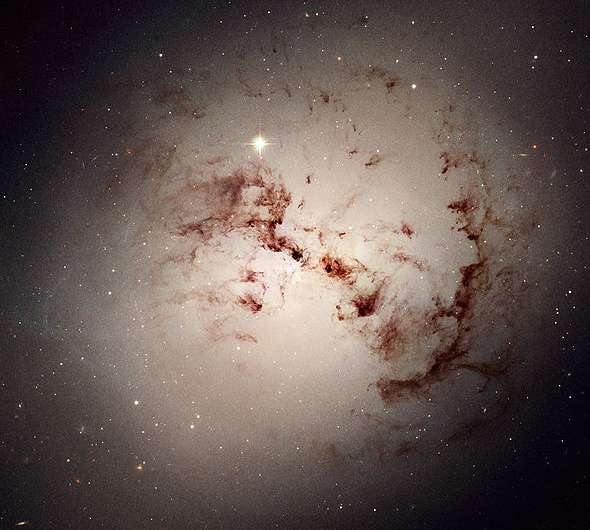March 20, 2017 report
Astronomers investigate a mysterious isolated star cluster complex

(Phys.org)—Astronomers have inspected a mysterious isolated star cluster complex designated SH2 in the galaxy NGC 1316 (also known as Fornax A). The results of their study, which were published Mar. 1 in a paper on arXiv.org, reveal important insights into the nature of this complex, providing crucial information about its origin.
Located some 62 million years away in the constellation Fornax, NGC 1316 is one of the brightest radio sources in the sky, classified as a lenticular radio galaxy. While the galaxy is dominated by old and intermediate-age stars, it shows signs of previous galaxy interactions. However, the only indicator of current star formation in this galaxy is the HII region SH2.
This peculiar isolated star cluster complex is located in the southern outskirts of NGC 1316. With a ring-like morphology and an estimated age of about 100 million years, SH2 contains approximately 100 young star clusters. Although this complex has been the subject of few studies in the past, its origin still remains a mystery.
In order to reveal more details of this interesting region of NGC 1316, a team of astronomers led by Tom Richtler of the University of Concepcion in Chile observed it in October 2012. The observations were carried out with the Visible MultiObject Spectrograph (VIMOS) mounted on the ESO Very Large Telescope (VLT) in Chile. The researchers used VIMOS to study SH2's morphology, kinematics, and metallicity employing line maps, velocity maps, and line diagnostics of a few characteristic spectra.
"We used the Integral Field Unit of the VIMOS instrument, where each pixel of the field corresponds to a spectrum rather than to only one intensity value as in normal imaging. Therefore, this kind of instrument provides a very efficient way of gathering astrophysical information," Richtler told Phys.org.
The team conducted these observations with the main aim of testing the hypothesis of SH2 being an infalling dwarf galaxy. Richtler noted that this assumption is quite reasonable, given the shells and ripples in NGC 1316, witnessing other infalling dwarf galaxies. Moreover, SH2 has the typical size of a dwarf galaxy.
"Star formation would then be initiated by the shock in the gas of the precursor of SH2. This is a phenomenon that we see quite frequently in other dwarf galaxies that accompany bigger galaxies," Richtler added.
However, the strong-line diagnostic diagrams and empirical calibrations described in the paper show a high metallicity of SH2, which does not confirm this theory. The results rather favor a scenario in which a molecular cloud complex (which could form during a merger about 2 billion years ago) started a star-forming process approximately 100 million years ago.
"The metal content must be low, as invariably found for dwarf galaxies. Therefore, SH2 is not an infalling dwarf galaxy, but has formed within a big gas cloud which had its origin in some galaxy interactions more than 1 billion years ago. SH2 is an example of how the still enigmatic globular cluster formation might have happened in the past," Richtler concluded.
The researchers plan further observations of SH2 using VLT's other Integral Field Units, which could reveal more insights into the nature of this region. In particular, they want to know how a big molecular cloud complex could survive for 1 billion to 2 billion years without star formation, and why it has a ring-like morphology. The team will also investigate why the star formation process was so efficient in producing bound massive star clusters and not field stars.
More information: The globular cluster system of NGC 1316 IV. Nature of the star cluster complex SH2, arXiv:1703.00313 [astro-ph.GA], arxiv.org/abs/1703.00313
© 2017 Phys.org





















